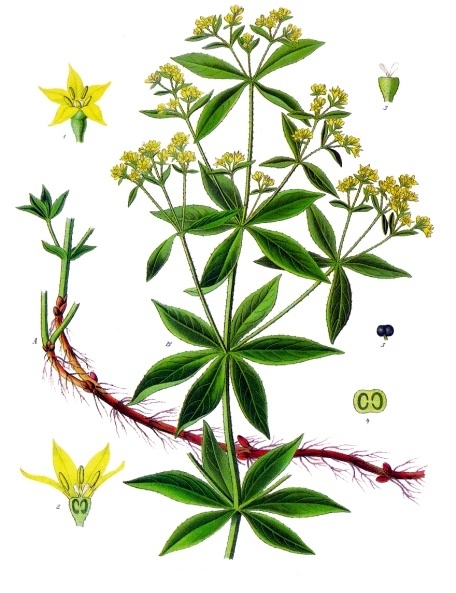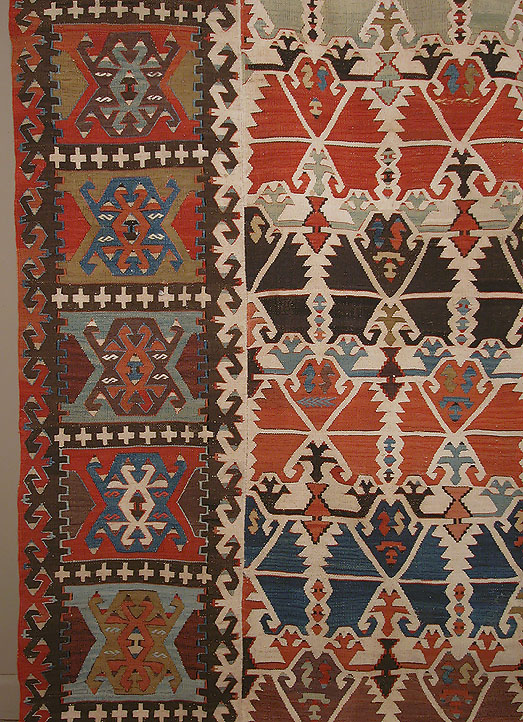|
Bergama Carpet
Bergama Carpet refers to handwoven Turkish carpets, made in the Bergama district in the Izmir Province of northwest Turkey. As a market place for the surrounding villages, the name of Bergama is used as a trade name to define the provenience. Geographically, the Bergama district includes the regions of Kozak, Yuntağ, Yağcibedir, and Akhizar. Of these, the regions of Yuntağ and Yağcibedir weave carpets which are iconographically different from the Bergama Type. The Bergama district includes around 70-80 villages, in many of whom carpets are woven. The history of carpet weaving in Bergama probably dates back to the 11th century. Bergama carpets still exist which date from the early 15th century, and are on display in, amongst other museums, the Türk ve Islam Eserleri Müzesi, Istanbul, the Pergamon Museum, Berlin, and the Metropolitan Museum of Art, New York. Manufactured, "village", and "nomadic" carpets Bergama carpets can be divided into such as produced in manufactur ... [...More Info...] [...Related Items...] OR: [Wikipedia] [Google] [Baidu] |
Carpet
A carpet is a textile floor covering typically consisting of an upper layer of pile attached to a backing. The pile was traditionally made from wool, but since the 20th century synthetic fibers such as polypropylene, nylon, or polyester have often been used, as these fibers are less expensive than wool. The pile usually consists of twisted tufts that are typically heat-treated to maintain their structure. The term ''carpet'' is often used in a similar context to the term ''rug'', but rugs are typically considered to be smaller than a room and not attached to the floor. Carpets are used for a variety of purposes, including insulating a person's feet from a cold tile or concrete floor, making a room more comfortable as a place to sit on the floor (e.g., when playing with children or as a prayer rug), reducing sound from walking (particularly in apartment buildings), and adding decoration or color to a room. Carpets can be made in any color by using differently dyed fibers. C ... [...More Info...] [...Related Items...] OR: [Wikipedia] [Google] [Baidu] |
DOBAG Carpet Initiative
DOBAG is the Turkish acronym for "Doğal Boya Araştırma ve Geliştirme Projesi" (the Natural Dye Research and Development Project). The project aims at reviving the traditional Turkish art and craft of carpet weaving. It provides inhabitants of a rural village in Anatolia – mostly female – with a regular source of income. The DOBAG initiative marks the return of the traditional rug production by using hand-spun wool dyed with natural colours, which was subsequently adopted in other rug-producing countries. Background and history The DOBAG project started in 1981, led by Harald Boehmer, a German chemistry and biology teacher, in cooperation with the Marmara University in Istanbul. He focused on chemical analyses of the dyes of antique woven carpets, such as those on display in Istanbul museums. Use of synthetic dyes in Oriental carpets Synthetic dyes were discovered in the late 19th century. Until then, wool used for weaving carpets was dyed with traditional dyes made ... [...More Info...] [...Related Items...] OR: [Wikipedia] [Google] [Baidu] |
Kilim
A kilim ( az, Kilim کیلیم; tr, Kilim; tm, Kilim; fa, گلیم ''Gilīm'') is a flat tapestry-woven carpet or rug traditionally produced in countries of the former Persian Empire, including Iran, the Balkans and the Turkic countries. Kilims can be purely decorative or can function as prayer rugs. Modern kilims are popular floor coverings in Western households. Etymology The term 'kilim' originates from the Persian ''galīm'' (گلیم) where it means 'to spread roughly', perhaps of Akkadian or Aramean origin. another name for Galim(Gilim) is Plas, Ferdowsi and other persian poet mentioned both Galim and plas as synonyms in Shahnameh No 35 mentioned as Plas(pluNo14 mentioned as Gali History Like Pile weave, pile carpets, kilim have been produced since ancient times. The explorer Mark Aurel Stein found kilims dating to at least the fourth or fifth century CE in Hotan, China: :"As kilims are much less durable than rugs that have a pile to protect the warp and weft, it is ... [...More Info...] [...Related Items...] OR: [Wikipedia] [Google] [Baidu] |
Knot Density
Knot density is a traditional measure for quality of handmade or knotted pile carpets. It refers to the number of knots, or knot count, per unit of surface area - typically either per square inch (kpsi) or per square centimeter (kpsc), but also per decimeter or meter (kpsd or kpsm). Number of knots per unit area is directly proportional to the quality of carpet.Cucker, Felipe (2013). ''Manifold Mirrors: The Crossing Paths of the Arts and Mathematics'', p.89-90. Cambridge University. . "The knot density...not only provides a measure of the work required to produce a given rug but also sets limits to the possible designs." Density may vary from or higher, where ≤80 kpsi is poor quality, 120 to 330 kpsi is medium to good, and ≥330 kpsi is very good quality. The inverse, knot ratio, is also used to compare characteristics. Knot density = warp×weft while knot ratio = warp/weft. For comparison: 100,000/square meter = 1,000/square decimeter = 65/square inch = 179/''gereh''. For ... [...More Info...] [...Related Items...] OR: [Wikipedia] [Google] [Baidu] |
Warp And Woof
Warp and weft are the two basic components used in weaving to turn thread or yarn into fabric. The lengthwise or longitudinal warp yarns are held stationary in tension on a frame or loom while the transverse weft (sometimes woof) is drawn through and inserted over and under the warp. A single thread of the weft crossing the warp is called a ''pick''. Terms vary (for instance, in North America, the weft is sometimes referred to as the ''fill'' or the ''filling yarn'').Barber (1991), p. 79 Each individual warp thread in a fabric is called a ''warp end'' or ''end''.Burnham (1980), pp. 170, 179 Inventions during the 18th century spurred the Industrial Revolution, with the "picking stick" and the "flying shuttle" ( John Kay, 1733) speeding up the production of cloth. The power loom patented by Edmund Cartwright in 1785 allowed sixty picks per minute. Etymology The word ''weft'' derives from the Old English word ''wefan'', to weave. ''Warp'' means "that which is thrown away" (O ... [...More Info...] [...Related Items...] OR: [Wikipedia] [Google] [Baidu] |
Warp (weaving)
Warp and weft are the two basic components used in weaving to turn thread or yarn into fabric. The lengthwise or longitudinal warp yarns are held stationary in tension on a frame or loom while the transverse weft (sometimes woof) is drawn through and inserted over and under the warp. A single thread of the weft crossing the warp is called a ''pick''. Terms vary (for instance, in North America, the weft is sometimes referred to as the ''fill'' or the ''filling yarn'').Barber (1991), p. 79 Each individual warp thread in a fabric is called a ''warp end'' or ''end''.Burnham (1980), pp. 170, 179 Inventions during the 18th century spurred the Industrial Revolution, with the "picking stick" and the " flying shuttle" ( John Kay, 1733) speeding up the production of cloth. The power loom patented by Edmund Cartwright in 1785 allowed sixty picks per minute. Etymology The word ''weft'' derives from the Old English word ''wefan'', to weave. ''Warp'' means "that which is thrown away" ... [...More Info...] [...Related Items...] OR: [Wikipedia] [Google] [Baidu] |
Ghiordes Knot
A knotted-pile carpet is a carpet containing raised surfaces, or piles, from the cut off ends of knots woven between the warp and weft. The Ghiordes/Turkish knot and the Senneh/Persian knot, typical of Anatolian carpets and Persian carpets, are the two primary knots.Goswami, K.K.; ed. (2009). ''Advances in Carpet Manufacture'', p.239. Woodhead Publishing in Textiles: Number 87 ( The Textile Institute). . "The two most common types of knot used in an oriental carpet are the Persian knot and the Turkish knot." A flat or tapestry woven carpet, without pile, is a kilim. A pile carpet is influenced by width and number of warp and weft, pile height, knots used, and knot density. "The structural weft threads alternate with supplementary weft that rises from the surface of the weave at a perpendicular angle. This supplementary weft is attached to the warp by one of three knots... to form the pile or nap of the carpet." Knots are tied in rows, one to each pair of warp threads, which may ... [...More Info...] [...Related Items...] OR: [Wikipedia] [Google] [Baidu] |
Hijri Year
The Hijri year ( ar, سَنة هِجْريّة) or era ( ''at-taqwīm al-hijrī'') is the era used in the Islamic lunar calendar. It begins its count from the Islamic New Year in which Muhammad and his followers migrated from Mecca to Yathrib (now Medina). This event, known as the Hijrah, is commemorated in Islam for its role in the founding of the first Muslim community (''ummah''). In the West, this era is most commonly denoted as AH ( la, Anno Hegirae , 'in the year of the Hijra') in parallel with the Christian (AD), Common (CE) and Jewish eras (AM) and can similarly be placed before or after the date. In predominantly Muslim countries, it is also commonly abbreviated H ("Hijra") from its Arabic abbreviation '' hāʾ'' (). Years prior to AH 1 are reckoned in English as BH ("Before the Hijrah"), which should follow the date. A year in the Islamic lunar calendar consists of twelve lunar months and has only 354 or 355 days in its year. Consequently its New Year's Day occurs ... [...More Info...] [...Related Items...] OR: [Wikipedia] [Google] [Baidu] |
Orhan Of The Ottoman Empire
Orhan Ghazi ( ota, اورخان غازی; tr, Orhan Gazi, also spelled Orkhan, 1281 – March 1362) was the second bey of the Ottoman Beylik from 1323/4 to 1362. He was born in Söğüt, as the son of Osman I. In the early stages of his reign, Orhan focused his energies on conquering most of northwestern Anatolia. The majority of these areas were under Byzantine rule and he won his first battle at Pelekanon against the Byzantine Emperor Andronikos III Palaiologos. Orhan also occupied the lands of the Karasids of Balıkesir and the Ahis of Ankara. A series of civil wars surrounding the ascension of the nine-year-old Byzantine emperor John V Palaiologos greatly benefited Orhan. In the Byzantine civil war of 1341–1347, the regent John VI Kantakouzenos married his daughter Theodora to Orhan and employed Ottoman warriors against the rival forces of the empress dowager, allowing them to loot Thrace. In the Byzantine civil war of 1352–1357, Kantakouzenos used Ottoman forces a ... [...More Info...] [...Related Items...] OR: [Wikipedia] [Google] [Baidu] |







